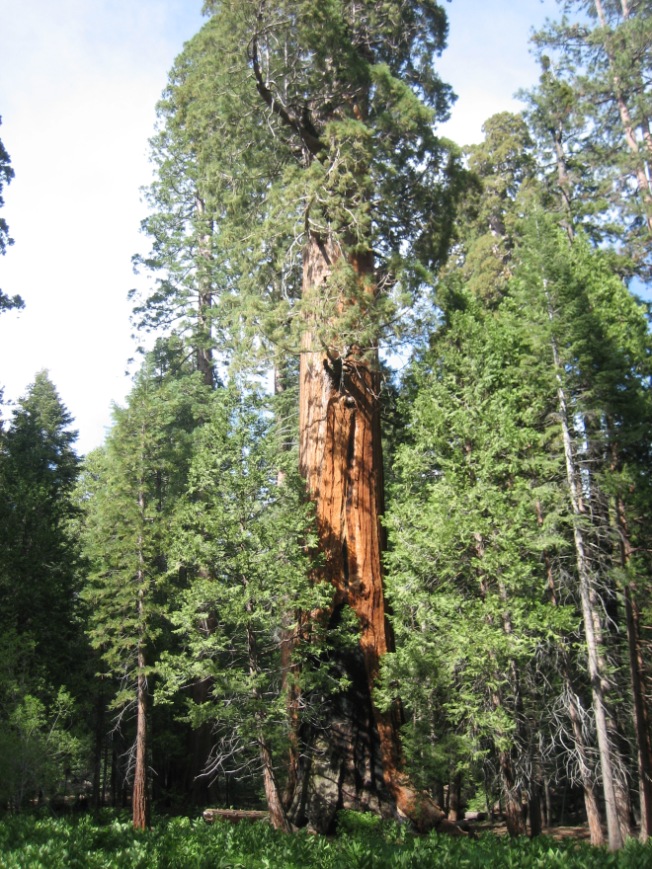One of the most frequent questions I am asked in the line of duty (meaning when I collect money in the parking lot) is What is the difference between a sequoia and a redwood? Related confusion is exhibited when visitors refer to the trees they are about to see/have just seen as “redwoods” or when people tell me they saw sequoias north of San Francisco. I feel it is my duty to correct such mistakes. The company I work for may see me as nothing more than a money collector, but I see myself as an educator.
When I visited Sequoia National Park, I bought an oversize postcard explaining the differences between giant sequoias trees and coast redwoods. The postcard’s copyright belongs to the Sequoia Natural History Association and has a date of 2009. I bought the postcard so I’d have something I could show folks in order to alleviate their sequoia/redwood confusion. As a service to my readers, I will summarize the information on the card (as well as information on a handout I was given by a Forest Service employee) and alleviate any confusion you may have regarding these trees.
The trees are in the same family, but we know they are not the same because they have different scientific names. The scientific name of the giant sequoia is sequoiadendron giganteum The scientific name of the coast redwood is sequoia sempervirens.
The easiest way to tall a giant sequoia from a coast redwood is location. While both grow naturally in California, coast redwoods live on the northern coast of California, and giants sequoias live on the Western slope of the Sierra Nevada mountains between 5,000 and 7,000 feet elevation.
(Instead of referring to where trees live, in the case of the giant sequoias, we must talk about where the trees occur naturally and/or reproduce. While reading the book Giant Sequoias by R.J. Hartesveldt; H.T. Harvey; H.S. Shellhammer; and R.E. Stecker, I learned giant sequoias live throughout Europe, although the trees currently living there did not occur naturally—people planted the seeds the trees grew from—and the trees are not reproducing naturally there. I am unsure if coast redwoods grow—naturally or otherwise—anywhere other than the coast of California.)
Another difference between coast redwoods and giant sequoias is size. Coast redwoods are taller than giant sequoias. In fact, coast redwoods are the tallest trees in the world, reaching heights up to 367.8 feet. The tallest giant sequoia is “only” 311 feet. Giant sequoias, however, are wider, with widths up to 40 feet, compared to the widths of coast redwoods of up to 22 feet. Giant sequoias are the largest living trees; they contain a greater volume of wood than any other trees, due to their height and great width. Giant sequoias weigh up to 2.7 million pounds, while coast redwoods weigh up to 1.6 million pounds. Part of the reason for the weight and volume difference is the thickness of the bark of the trees. The bark of giant sequoias can be up to 31 inches thick, while the bark of coast redwoods can be up to 12 inches thick.
Both giant sequoias and coast redwoods reproduce by seeds, although coast redwoods can also reproduce by sprout. (Giant sequoias don’t reproduce by sprout.) Coast redwoods have seeds that look like tomato seeds, while giant sequoia seeds look like oat flakes. Both trees produce cones in which their seeds grow, but the cones are of different sizes. The cones of giant sequoia trees are about the size of a chicken’s egg, while the cones of coast redwoods are the size of an olive.
Giant sequoias live longer than redwoods. The oldest giant sequoia is thought to be 3,200 years old, while the oldest coast redwood is believed to be 2,000 years old.
Finally, all giant sequoias are protected by law from being harvested, while coast redwoods can legally be harvested and used for lumber.
So now you know the difference(s) between coast redwoods and giant sequoias. My work today is done.
